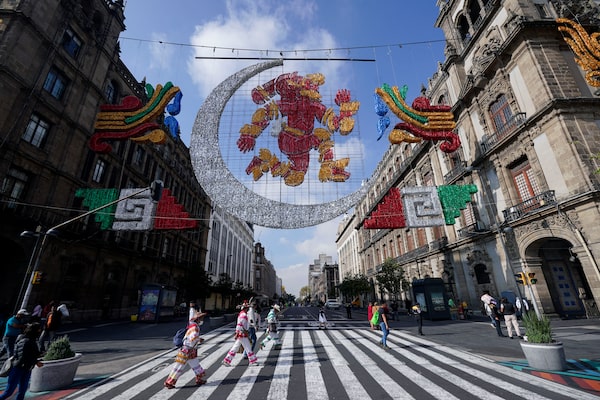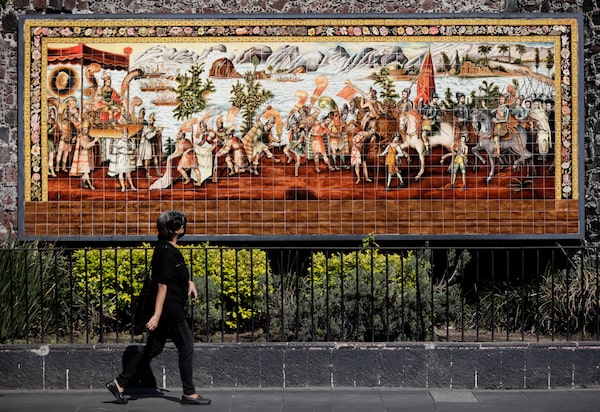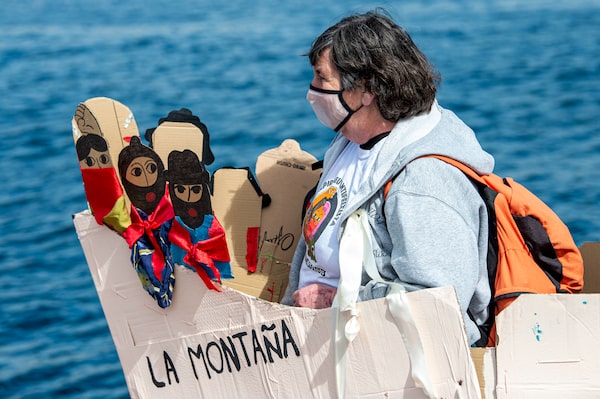Dancers perform at Mexico City's central Zocalo square this past July to mark the anniversary of the founding of Tenochtitlan, the Aztec capital city that Hernan Cortes conquered for Spain in the 1520s.Luis Cortes/Reuters
Legend has it Spanish conquistador Hernan Cortes wept under a Moctezuma cypress tree after the Mexica drove him from their island capital in 1520. He cried for his lost men – reputedly weighed down by gold and slain as they fled over a causeway – and for the Indigenous people who had fought alongside him.
The debacle became known as the “Night of Sorrows.” It preceded his return the next year, when Cortes and his allies overthrew the Aztec empire and conquered Tenochtitlan, which would become Mexico City.
To mark this year’s 500th anniversary of Tenochtitlan’s fall, the Mexico City government renamed the plaza containing the cypress stump “Plaza of the Victorious Night” – an attempt to “give voice to the original peoples of our territory,” according to Mayor Claudia Sheinbaum.
“If we say the night of sorrows, we think of Cortes and the conquest,” Ms. Sheinbaum said at the ceremony. “If we say victorious night, we honour those who died in the massacre at the Templo Mayor and the population of Tenochtitlan.”
Critics panned the renaming as political – same as they did for the national government celebrating the 700-year anniversary of the founding of Tenochtitlan, a date historians consider dubious. The episode has underscored the enduring controversy of the conquest, an event that produced many of the country’s foundational myths. Hispanophiles cling to notions of Cortes and the Spanish bringing civilization, religion and language to Mexico. Indigenous peoples see the conquest – referred to as the “so-called conquest” – as an unmitigated disaster.

Aztec pride at the Zocalo: At top, a display at the represents moon goddess Coyolxauhqui, and at bottom, workers assemble a model of the Templo Mayor (Great Temple) pyramid.Eduardo Verdugo/The Associated Press, Toya Sarno Jordan/Reuters
The Mexico City government is promoting remembrance. It’s reconstructing a model of the Templo Mayor, or Great Temple, in the central Zocalo plaza, near where it originally stood.
Nationally, President Andres Manuel Lopez Obrador has declared 2021 the “Year of Independence and the Greatness of Mexico,” with plans to mark the 200th anniversary of Independence from Spain and the Tenochtitlan 500th anniversary. In May, he offered an apology for the massacre of 303 Chinese residents of Torreon during the revolution in 1911. He also proposed apologizing to the Yaqui and Maya peoples for atrocities committed by the independent Mexico.
But Mr. Lopez Obrador, commonly called “AMLO,” has also fanned the flames of controversy in recent years. He sent letters to the Spanish crown and Pope Francis, asking them to plead forgiveness. “The so-called conquest was waged with the sword and the cross,” he said in 2019 after sending the letters. “The time has come to reconcile. But let us ask forgiveness first.”
Spain rejected the call, saying “the arrival of the Spanish on Mexican soil 500 years ago cannot be judged in the light of contemporary considerations.” Pope Francis previously apologized while visiting Bolivia in 2015 for “not only for the offence of the church herself, but also for crimes committed against the native peoples during the so-called conquest of America.”
The letters wrong-footed AMLO’s opponents, according to observers, as their criticism ended up defending Spain at the expense of Mexico. “This is about backing his enemies into a corner, where he assumes they will back Spain,” said Federico Estevez, a political-science professor at the Autonomous Technological Institute of Mexico. “He’s willing to open the wounds. Let’s see how people react.”

A woman passes a mural commemorating the meeting of Cortes, on horseback at right, and the Aztec emperor Moctezuma II, left. Moctezuma would live his last days as a hostage in his own city.Eduardo Verdugo/The Associated Press
Attitudes toward Spain can be complicated. The same for Hernan Cortes – a figure associated with plunder and evil by many Mexicans. But he’s become an enormous source of interest, with several streaming series made on his adventures in Mesoamerica.
AMLO quipped of Cortes in 2019 that he “had barely disembarked in Veracruz and without any legal basis … he named himself mayor. It was the first fraud.”
The Spanish far-right rebuked AMLO’s assertions. It has embraced Cortes and the conquest “in an attempt to legitimize themselves,” said Harim B. Gutierrez, a historian at the Autonomous Metropolitan University in Mexico City. “The historical idea inculcated in Mexico over many years … was that Mexico was a mestizo nation. The fall of Tenochtitlan was seen as the key point in the process of becoming mestizo.”
Cortes’s legend was burnished by his supposed ability to sack an empire with just a small squadron of men. (Disease later did in many of the conquered Indigenous peoples.) Historians are revising that claim – and much of the conquest. In reality, he depended on Indigenous allies – such as the Tlaxcalans to the east of Tenochtitlan – who were at odds with the Mexica.
“Less than one per cent of the attackers besieging Tenochtitlan were Spanish,” said Matthew Restall, historian and author of When Moctezuma Met Cortés: The True Story of the Meeting that Changed History.
“The conquistadors were allies of the Mesoamericans. It’s better we speak of Indigenous conquistadors … and their European partners in crime,” Mr. Restall wrote in Nexos magazine earlier this month.

Activists in solidarity with the Zapatista movement await the arrival of a delegation from Mexico in Vigo, Spain, this past June.Octavio Passos/Getty Images
Indigenous peoples are raising their voices ahead of the conquest’s anniversary. The Zapatistas, who led a 1994 uprising in Chiapas state, sent a ship to Spain on May 2, along with a pair of messages. “One, they didn’t conquer us,” a statement said. “Second, they do not have to ask that we forgive them for anything.”
Jose Angel Koyoc Ku, a Mayan historian, says Mexico still clings to the notion of a “mestizo nation” as other countries in Latin America such as Bolivia, Chile and Peru are raising the concept of being “pluri-national.”
“It’s not even being verbalized here,” Mr. Koyoc Ku said. “Mayan communities are questioning the narrative of a single homogeneous country and I think the Mexican state continues being quite reluctant.”
The conquest’s anniversary comes as AMLO’s relationship with Indigenous communities deteriorates – the product of him pushing megaprojects such a train circling the Yucatan Peninsula, which Maya communities say they’ve not been properly consulted on.
The conquest’s legacy remains complicated for many in Mexico, even after 500 years. “It’s something that brings out many difficult and complex things about being Mexican,” said Emiliano Ruiz Parra, an author and journalism instructor, including racism.
He continued: “Why vindicate the Indigenous of the past who no longer exist, when the Indigenous of today continue being those who unfortunately make up most of the extreme poverty numbers?”
At the Zocalo, a woman takes a selfie with one of the dancers.Luis Cortes/Reuters
Our Morning Update and Evening Update newsletters are written by Globe editors, giving you a concise summary of the day’s most important headlines. Sign up today.